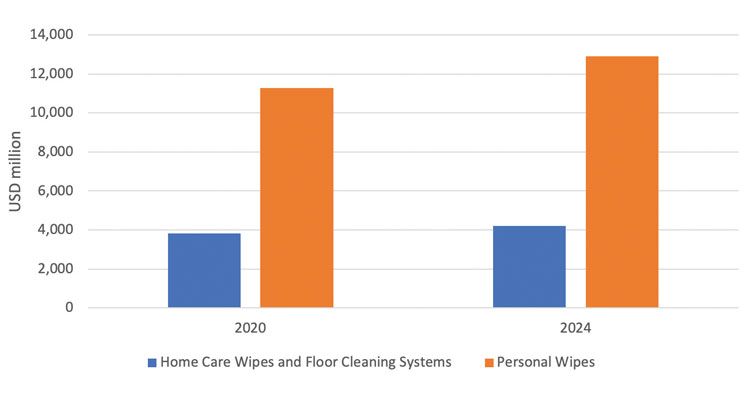Part
01
of one
Part
01
Plastic Content of Fibers in Wipes
Wipes and other sanitary disposables are responsible for the build-up of microplastics in the environment and the human food chain. Apart from constituting 90% of materials accountable for sewer blockages in the UK, new research now shows that sanitary wipes contain non-biodegradable plastics. As the production of “hygiene and personal care” wipes continues to rise, researchers are concerned about the emergence of microplastics as a contaminant.
Plastic Content of Fibers in Wipes — Findings
Study 1 (Oisin et al. 2020)
- A study investigating the role of sanitary towels and wet wipes as sources of white microplastic fibers in the marine environment found out that 50% of the brands tested —and were labeled “flushable”— contained a mixture of PET (polyethylene terephthalate) and cellulose. The non-flushable varieties contain PET and cellulose or PP (polypropylene).
- A white microfiber polymer analysis on randomly selected intertidal sediments (n = 100) in various locations in the UK produced insights that may reveal the quantity of microplastics in wipes. White fiber from the sediment from Mutton island (n = 86) was identified as PET (n = 51; 59.3%), PP (n = 23; 26.7%), polyester (PES) (n = 9; 10.4%), polystyrene (PS; n = 2; 2.3%) and acrylonitrile butadiene styrene (ABS; n = 1; 1.1%). In Bell Harbour, (n = 7) white fibers were identified as ABS (n = 4; 57.1%), PP (n = 2; 28.5%) and PS (n = 1; 14.2%). Finally, in Bellacragher (n = 7) white microfiber identified as ABS (n = 6; 85.7%) and PS (n = 1; 14.2%).
- This study did not mention the brand names of the products from which these findings were generated. However, it stated they were “commonly available flushable and non-flushable wet wipes and sanitary towels.”
Study 2 (BBC Expose)
- A 2019 BBC expose on ‘Hidden’ plastics shed further light on the issue of microplastics in ordinary wipes. The 60-minute episode that primarily relied on scientific findings showed that “90% of the 11 billion wipes sold in the UK every year contain plastic.”
- Laboratory tests on wipes made by the three largest wet wipes manufacturers in the country — Proctor & Gamble (P&G), Kimberly Clark, and Johnson & Johnson—contained at least 30% plastic.
- A spokesperson for Kimberly & Clark responded to BBC’s expose, saying the company “recognized the concerns highlighted by the BBC” and, in the future, would add an on-pack label showing the plastic content of its Huggies Baby Wipes. Currently, Huggies contains 35% plastic and 65% natural fiber and is sold in the U.S.
Study 3 (TUV Rheinland)
- TUV Rheinland carried out a series of tests on 33 common baby wet wipes and found a “high share of fossile-based synthetic fibers,” mostly polypropylene and polyester, in 28 wipes. This essentially implies that only three of the 33 baby products were made of biodegradable materials.
- The analysis further established that the proportion of synthetic materials in the wet wipes was around 30%. The detailed evaluation showed that most of the wipes had a plastic share of more than 50%, with some wipes having as high as 80% of these plastics.
Study 4 (Rengasamy, 2014)
- Rengasamy points out that viscose blended with wood pulp or polypropylene or polyester are the most common materials used to make dry wipe products such as baby wipes, food service wipes, cleanroom wipes, and dusters.
- These products are typically non-woven, which means they are made either by thermobonding, hydroentangling, chemical bonding, or needlepunching.
- The composition of standard baby wipes by material content is 70:30 viscose rayon-polyester and 50:50 viscose rayon-wood pulp in every basis weight of 55g/m2. On the other hand, food service wipes have a composition ratio of 80:20 viscose rayon-polyester in every basis weight (69-80g/m2).
- Dusters contain about 75 — 91% polyester and 9-25% polypropylene. To increase the fabric’s thermal bonding, the proportion of polypropylene is sometimes increased by 15%. Therefore, depending on the cleaning and strength qualities required, these products can have different plastic content.
